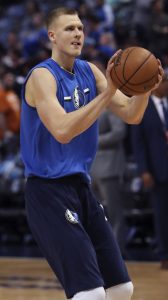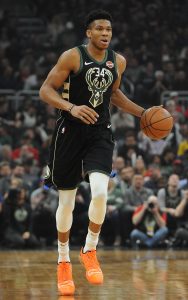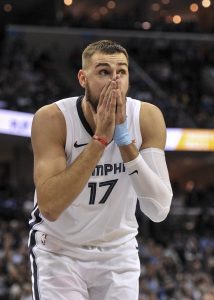Every week, Hoops Rumors takes a closer look at players who will be free agents or could become free agents next offseason. We examine if their stock is rising or falling due to performance and other factors. This week, we turn our attention to the Pacific Division:
Klay Thompson, Warriors, 29, SG (Up) – Signed to a four-year, $69MM deal in 2015
The smart money has Kevin Durant signing elsewhere this summer, which makes it more imperative for Golden State to keep its dynamic backcourt intact. The Warriors would probably have to max out Thompson at $190MM over five years and ownership appears willing to do so. If not, rivals with ample cap space would certainly give him a four-year, $140MM deal, the max they could offer. In any case, Thompson won’t have to take a discount the way the market figures to play out. Even in a somewhat down year by his standards, he still had the sixth-most 3-point makes in the NBA.
 Reggie Bullock, Lakers, 28, SG (Down) — Signed to a two-year, $5MM deal in 2017
Reggie Bullock, Lakers, 28, SG (Down) — Signed to a two-year, $5MM deal in 2017
The cap-strapped Pistons figured they couldn’t re-sign Bullock, so they traded him to the Lakers for a couple of assets. He was Detroit’s most reliable wing player but things didn’t go well for him in L.A. He never got into a shooting rhythm with the Lakers, as the career 39.2% long-range gunner made just 34.3% of his 3-point shots. Bullock’s price tag might have gone down somewhat, though he should still field some multi-year offers. He might even return to Detroit, where he played four seasons, if the Pistons can fit him into their budget.
Rodney McGruder, Clippers, 27, SF (Up) – Signed to a three-year, $3.4MM deal in 2016
McGruder finished his season in the Clippers organization, though he’s ineligible for the playoffs. Miami put him on waivers to get under the luxury tax and the Clippers claimed him. The Clippers gained control of his Early Bird rights and can make him a restricted free agent by extending a $3MM qualifying offer. It seems that McGruder might benefit from Miami’s surprising move, as he could claim a rotation role with his new club depending upon how well they do in free agency. If they choose not to give him a QO, he should be able to secure a contract on the open market befitting a second-unit player.
Jamal Crawford, Suns, 39, SG (Up) – Signed to a one-year, $2.39MM deal in 2018
How crazy is this? Crawford entered the league in 2000, the same year Zion Williamson was born. They could be teammates next season. That’s if Crawford decides re-sign with Phoenix. He wants to play at least another year and why not? This week, Crawford became the oldest player in NBA history to record a 50-point game. Crawford appeared in 64 games with Phoenix after playing a minimum of 79 the previous three years. He’ll be providing offense off the bench somewhere next season, a tribute to his preparation, perseverance and durability.
Willie Cauley-Stein, Kings, 25, C (Down)– Signed to a four-year, $15.35MM deal in 2015
Cauley-Stein said prior to the season he was “ready to get paid” after his walk year. He started all but one game this season for Sacramento but didn’t really enhance his value. He’s not a shot-blocker. He doesn’t rebound particularly well for his size. He can’t shoot free throws, nor does he pose much of an offensive threat. The Kings can make him a restricted free agent by extending a $6.25MM qualifying offer but even that’s not a given. Cauley-Stein will certainly get a raise compared to his rookie deal but it probably won’t be what he expected.
Photo courtesy of USA Today Sports Images.
 With that in mind, let’s check in on how this year’s RFAs-to-be will be impacted by the starter criteria. Listed below are the former top-14 picks on track for restricted free agency who have not met the starter criteria. These players will be eligible for qualifying offers worth $4,485,665.
With that in mind, let’s check in on how this year’s RFAs-to-be will be impacted by the starter criteria. Listed below are the former top-14 picks on track for restricted free agency who have not met the starter criteria. These players will be eligible for qualifying offers worth $4,485,665.
 Our overall results were modest, but did our “best bets” do any better? Let’s take a look. These were the five predictions that received the largest share of the vote:
Our overall results were modest, but did our “best bets” do any better? Let’s take a look. These were the five predictions that received the largest share of the vote: Jonas Valanciunas
Jonas Valanciunas